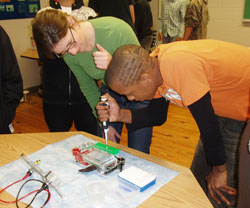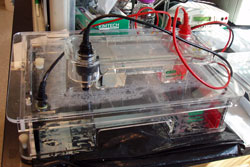Culturing bacteria is a relatively easy way to count bacteria in a sample, but do cultures give us a truly accurate bacterial abundance? Since not all bacteria can grow under “unnatural” laboratory conditions (actually most do not), bacterial cultures only tell us how many culturable bacteria are in a sample, rather than a total count. Also, how do scientists figure out who is in the sample, and what are they doing? As technology evolves, we turn to techniques that allow us to genetics to study bacteria and other microbes.
Scientists use a variety of genetic techniques to study marine bacteria, as outlined in this module’s Explore Trends page. In this activity, students will conduct “virtual labs” to explore how scientists extract DNA from samples, amplify the DNA (PCR/Polymerase Chain Reaction), and study the DNA (gel electrophoresis). Of course, “doing science” through hands-on activities are ideal. If your school is equipped with electrophoresis equipment or has the resources to obtain the equipment, the lesson resources section contains some links and documents outlining hands-on electrophoresis activities.
Objectives
- Students will understand current approaches in genetic research
- Students will apply their understanding of these approaches to studying microbes in the ocean
Materials
- Computers with internet access
- Student Worksheet
Procedure
- Have students visit the websites provided and run through the virtual genetics labs.
- Students should answer the questions on the Student Worksheet (also outlined below).
Go to the DNA Extraction Virtual Laboratory.
Answer the following questions after you finish the lab:
- Why do we need to perform DNA extraction in order to perform genetic analysis?
- What three basic steps to we follow to extract DNA from a cell?
Polymerase Chain Reaction (PCR)
Go to the Virtual PCR Lab
Answer the following question after you finish the lab:
- Why do scientists need to run PCR in order to work with DNA?
Gel Electorphoresis
Go to the Virtual Gel Electrophoresis Lab
Answer the following question after you finish the lab:
- Gel electrophoresis sorts DNA strands by length because longer DNA strands travel through the gel slower than shorter strands. Why do scientists need to sort DNA strands by length?
Real World Genetics
You’re a surfer and a microbiologist. You want to find out if the near-by sewage treatment plant is contaminating your favorite beach with harmful bacteria species, so you collected a water sample while you were paddling out to catch some sick waves one day. Write a brief paragraph or provide bullet points, or draw a storyboard outlining how you would use genetic analysis to figure out whether the bacteria in question is in your sample. Be sure to explain why you chose to carry out each step.
Lesson Resources
Learn Genetics Website from the University of Utah. Contains a great deal of information on genetic science. The virtual labs on this website (links above) contain instructions for hands-on versions of DNA extraction and gel electrophoresis.
Carolina Biological Supply: access to gel electrophoresis supplies adapted for classroom use
National Science Education Standards
9-12 C Life Science
- The cell
- Molecular basis of heredity
- Biological evolution
9-12 E Science and Technology
- Abilities of technological design
- Understandings about science and technology
9-12 F Science in Personal and Social Perspectives
- Personal and community health
